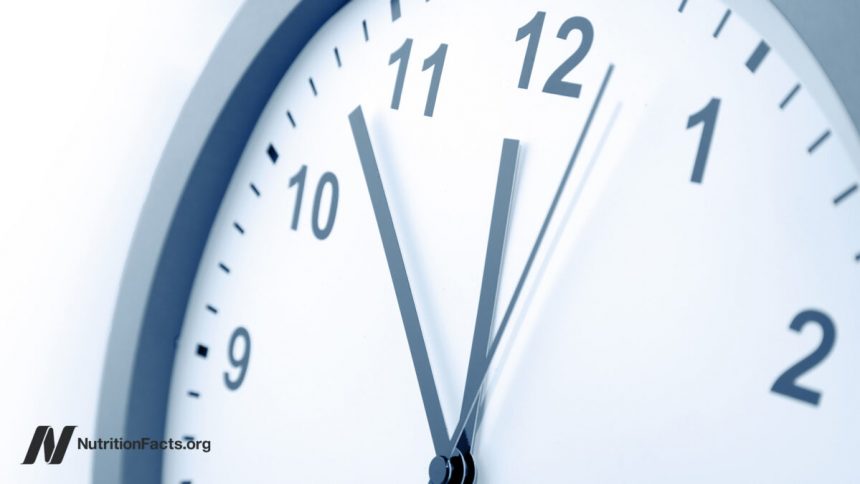HTML Content:
Given the power of chronotherapy—how the same dose of the same drugs taken at a different time of day can have such different effects—it’s no surprise that chronoprevention approaches, like meal timing, can also make a difference. The 2017 Nobel Prize in Medicine was awarded for “elucidating molecular mechanisms of the circadian clock,” our internal clock. For billions of years, life on Earth evolved to a 24-hour cycle of light and dark, so it’s no surprise our bodies are finely tuned to that pattern.
But, even when we’re in total darkness without any external time cues, our body continues to cycle in about a 24-hour circadian rhythm. You can even take tissue biopsies from people and show the cells continue to cycle outside the body in a petri dish. Nearly every tissue and organ in our body has its internal clock. An intricate system of intrinsic clocks drives not only some of our behavioral patterns, such as eating, fasting, sleeping, and wakefulness, but it also drives our internal physiology—our “body temperature, blood pressure, hormone production, digestion, and immune activity.”
Most of the genes in our body “exhibit daily fluctuations in expression levels, making the circadian expression rhythms the largest known regulatory network in normal physiology,” the biggest regulatory system in our body. This cycling is thought to allow for a level of “‘predictability’ and ‘functional division of labor’” so that each of our body processes can run at the best time. At night while we’re sleeping, a whole array of internal housekeeping activities can be switched on, for example, and as dawn approaches, our body can shift back into activity mode.
Anyone who’s ever had jet lag knows what throwing off our cycle by even just a few hours can do, but now we know our circadian rhythms can be the difference between life and death. A study of more than 14,000 self-poisonings found that those who tried committing suicide in the morning were more than twice as likely to die than those who ingested the same dose in the evening. In the same vein, properly timed chemotherapy can not only end up being five times less toxic but also twice as effective against cancer. The same drugs, at the same dose, but with different effects depending on the time they’re given.
Our body absorbs, distributes, metabolizes, and eliminates what we ingest differently, depending on when it is during the 24-hour cycle, as you can see below and at 2:19 in my video Chronobiology: How Circadian Rhythms Can Control Your Health and Weight. We’re just beginning to figure out the optimal timing for different medications. Randomize people suffering from hypertension into taking their blood pressure pills at bedtime instead of in the morning, and not only does the bedtime group achieve better blood pressure control and suffer fewer heart attacks and strokes, but they cut their risk of death in half. (Yet, most physicians and pharmacists tell patients to take them in the morning, potentially doubling their risk of death.)
If chronotherapy—the optimal timing of drugs—can have such an impact, maybe it should come as no surprise that chronoprevention—the scheduling of lifestyle interventions like mealtimes—can also make a difference. In the official Academy of Nutrition and Dietetics position paper on effective treatments for obesity, importance is placed not only on the quantity but also on the timing of caloric intake. “Potentially consuming more energy [calories] earlier in the day, rather than later in the day, can assist with weight management.” Some have gone further and even characterized obesity as a “chronobiological illness.”
What evidence do we have to back up these kinds of claims? Well, the “timing of energy [caloric] and nutrient intake has shifted slightly over time, with a greater proportion of intake later in the day,” raising the question about a possible role in the rise of obesity. Middle-aged men and women who eat a greater share of daily calories in the morning do seem to gain less weight over time, and a study entitled “Timing of Food Intake Predicts Weight Loss Effectiveness” found that dieters eating their main meal earlier in the day seemed to steadily lose more weight than those eating their main meal later, as you can see in the graph below and at 4:12 in my video.
The obvious explanation for these findings would just be that those who eat later also tend to eat more. And, indeed, there does seem to be a relationship between when people eat most of their calories and how many calories they end up eating over the entire day, with those eating a greater proportion in the morning eating less overall. Maybe later eaters are overeating junk on the couch watching primetime TV? A tendency has been found for night owls to consume more fast food and soda, and fewer fruits and vegetables. In the field of social psychology, there is a controversial concept called “ego depletion,” where self-control is viewed as a limited resource, like a muscle that can become fatigued from overuse.
As the day wears on, the ability to resist unhealthy food choices may decline, leaving one vulnerable to temptation. So, is it just a matter of later eating leading to greater eating? In the study I mentioned above where earlier eaters steadily lost more weight, to the researchers’ surprise, the early eaters ate as much as the late eaters, despite the difference in weight-loss magnitude. By the end of the 20-week study, the early eaters ended up about five pounds lighter than the late eaters, even though the two groups ate the same amount of food. There didn’t seem to be any difference in physical activity between the two groups either. Could it be that just the timing itself of caloric intake matters?
Scientists decided to put it to the test, which we’ll cover next. Wasn’t that chemo data wild? If you are on blood pressure medications, please share this video with your physician and ask if your timing is optimized. We kicked off this chronobiology series by looking into the importance of breakfast when it comes to weight loss. In case you missed those videos, see Friday Favorites: Is Breakfast the Most Important Meal for Weight Loss, or Should It Be Skipped?. For more on this topic, check out the related posts below.
!function(f,b,e,v,n,t,s) {
if(f.fbq)return;
n=f.fbq=function(){n.callMethod?
n.callMethod.apply(n,arguments):n.queue.push(arguments)};
if(!f._fbq)f._fbq=n;n.queue=[];t=b.createElement(e);t.async=!0;
t.src=v;s=b.getElementsByTagName(e)[0]; s.parentNode.insertBefore(t,s)}(window, document,’script’,
‘https://connect.facebook.net/en_US/fbevents.js’);
fbq(‘init’, ‘1582627921973608’);
fbq(‘track’, ‘PageView’);
If the provided articles seems to be less than 200 characters or it is an intro of the author, then try to generate an articles using this title. Circadian Rhythms and Our Health and Weight.





